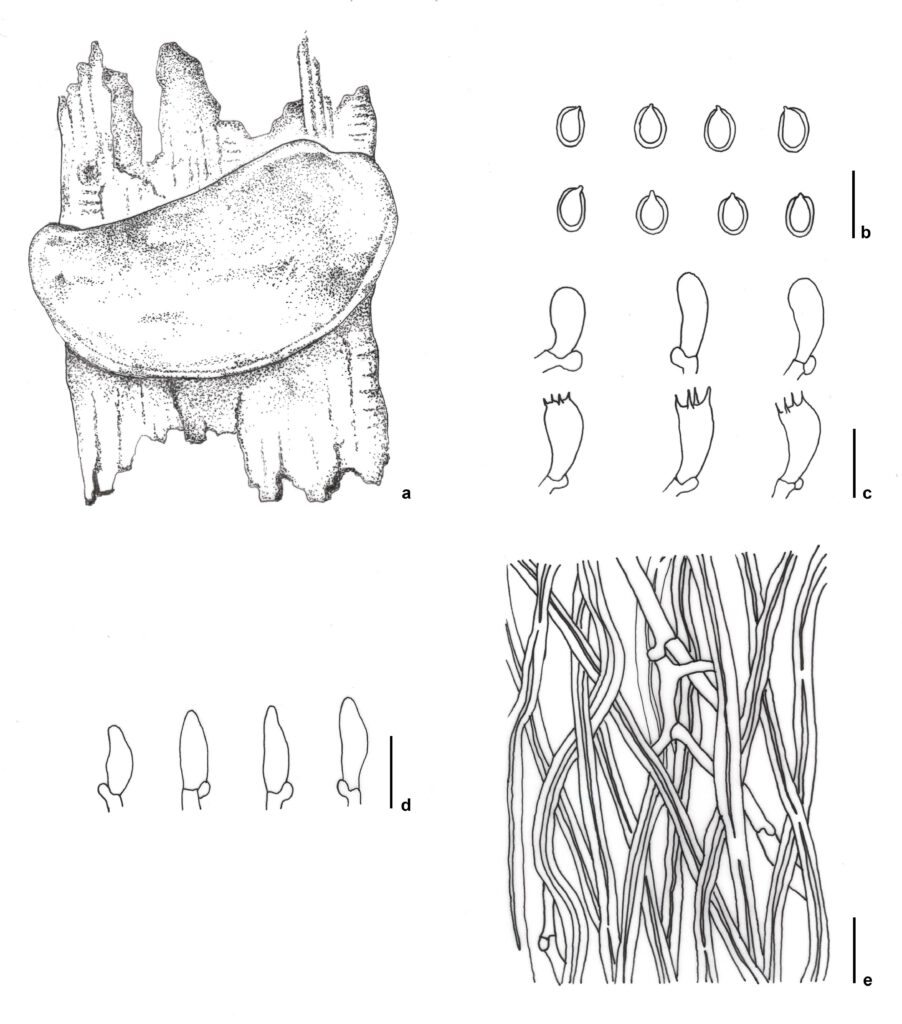Fungalpedia – Note 39 Abundisporus
Abundisporus Ryvarden
Index Fungorum, MycoBank, GenBank, Fig. 1
The genus Abundisporus Ryvarden typified by A. fuscopurpureus (Pers.) Ryvarden was established in 1998 while studying the diversity of the poroid mushrooms of tropical Africa (Ryvarden 1998). The basidiocarps are mostly of pileate to resupinate habit (Ryvarden 1998, Zhao et al. 2015). The context is usually of a range of colours from umber brown to greyish to purplish brown (Ryvarden 1998, Zhao et al. 2015). The hyphal system is dimitic with pale brown to yellow skeletal hyphae (Ryvarden 1998, Zhao et al. 2015). The basidiospores of this genus are generally pale yellowish, slightly thick-walled, ellipsoid, and non-dextrinoid (Ryvarden 1998, Zhao et al. 2015). The tissues of Abundisporus turns brownish on reaction with Potassium hydroxide (Zhao et al. 2015). Taxonomic studies revealed that this white rot forming genus has been recorded mostly from tropical to subtropical areas, but reports of A. pubertatis (Lloyd) Parmasto and A. quercicola Y.C. Dai were found in temperate areas (Parmasto & Hallenberg 2000, Lee & Jung 2006, Dai 2012, Zhao et al. 2015, Jargalmaa et al. 2015). Zhao et al. (2015) did a detailed taxonomic revision along with the molecular data (based on nrITS, nrLSU, mtSSU, tef1 sequence data) of Abundisporus diversity in China and further added another species, A. mollissimus B.K. Cui & C.L. Zhao under this genus. This study revealed the members of Abundisporus to be monophyletic belonging to the core polyporoid clade (Zhao et al. 2015). Simultaneously, Jargalmaa et al. (2015) initiated a revisionary work on this genus in Korea clarifying the status of the species and distinguishing the Abundisporus and similar polyporoid mushroom, Fomitopsis rosea based on micromorphology, molecular data and habitat. Currently, Abundisporus accommodates eight accepted species worldwide based on morphological characters and phylogenetic analysis.
Type species: Abundisporus fuscopurpureus (Pers.) Ryvarden
Other accepted species: A. mollissimus B.K. Cui & C.L. Zhao
A. pubertatis (Lloyd) Parmasto
A. quercicola Y.C. Dai
A. resupinatus Decock & Ryvarden
A. roseoalbus (Jungh.) Ryvarden
A. sclerosetosus Decock & Laurence
A. violaceus (Wakef.) Ryvarden
Fig 1. Abundisporus fuscopurpureus (Cui 10969). a. Basidiomata. b. Basidiospores. c. Basidioles and basidia. d. Cystidioles. e. Hyphae from trama. Scale bars: b = 5 μm, c-e = 10 μm. Drawn from Cui et al. 2019 and Zhao et al. 2015.
References
Cui, B. K., Li, H. J., Ji, X., Zhou, J. L., Song, J., Si, J., … & Dai, Y. C. (2019). Species diversity, taxonomy and phylogeny of Polyporaceae (Basidiomycota) in China. Fungal Diversity, 97, 137-392. https://link.springer.com/article/10.1007/s13225-019-00427-4
Dai YC 2012 – Polypore diversity in China with an annotated checklist of Chinese polypores. Mycoscience 53, 49–80. https://www.sciencedirect.com/science/article/abs/pii/S1340354012700098
Jargalmaa S, Park MS, Park JY, Fong JJ, Jang Y, Lim YW 2015 – Taxonomic study of the genus Abundisporus in Korea. Mycobiology 43(3), 225–230. https://www.tandfonline.com/doi/epdf/10.5941/MYCO.2015.43.3.225?needAccess=true&role=button
Lee JS, Jung HS 2006 – Taxonomic study on Korean Aphyllophorales (5): on some unrecorded genera and species. Mycobiology 34,166–175. https://www.ncbi.nlm.nih.gov/pmc/articles/PMC3769568/
Parmasto ER, Hallenberg NI 2000 – The genus Abundisporus (Hymenomycetes, Basidiomycotina). Karstenia 40,129-138. https://karstenia.fi/the-genus-abundisporus-hymenomycetes-basidiomycotina/
Ryvarden L 1998 – African polypores: a review. Belg. J. Bot. 131, 150–155. https://www.jstor.org/stable/43996255
Zhao CL, Chen H, Song J, Cui BK 2015 – Phylogeny and taxonomy of the genus Abundisporus (Polyporales, Basidiomycota). Mycological Progress 14, 38. https://link.springer.com/article/10.1007/s11557-015-1062-y#Sec1
Entry by
Ishika Bera, Center of Excellence in Fungal Research, Mae Fah Luang University, Chiang Rai 57100, Thailand
(Edited by Kevin D Hyde)
Published online 25 May 2023
